The Effect of Plants on the Energy Output of Green Roof Photovoltaic Systems in Tropical Climates
Abstract
1. Introduction
2. Materials and Methods
2.1. Green Roof Photovoltaic (GRPV) System
2.2. 280-Watt Poly-Crystalline Solar Panels
2.3. Calico Plant (Alternanthera Bettzickiana)
2.4. Data Collection
3. Results
4. Discussion
Energy Production at Unit Scale
5. Conclusions
Author Contributions
Funding
Institutional Review Board Statement
Informed Consent Statement
Data Availability Statement
Acknowledgments
Conflicts of Interest
References
- Maftouni, N.; Khodami, S.S. Climate comparative building energy optimization: A retrofit approach including solar photovoltaic panels and natural ventilation. J. Sol. Energy Res. 1999, 5, 314–331. [Google Scholar]
- Al Asbahi, A.A.M.H.; Fang, Z.; Chandio, Z.A.; Tunio, M.K.; Ahmed, J.; Abbas, M. Assessing barriers and solutions for Yemen energy crisis to adopt green and sustainable practices: A fuzzy multi-criteria analysis. Environ. Sci. Pollut. Res. 2020, 27, 36765–36781. [Google Scholar] [CrossRef] [PubMed]
- Isaac, M.; van Vuuren, D.P. Modeling global residential sector energy demand for heating and air conditioning in the context of climate change. Energy Policy 2009, 37, 507–521. [Google Scholar] [CrossRef]
- IPCC. Summary for Policymakers. In Global Warming Of 1.5 °C. An IPCC Special Report on the Impacts of Global Warming Of 1.5 °C above Pre-Industrial Levels and Related Global Greenhouse Gas Emission Pathways, in the Context of Strengthening the Global Response to the Threat of Climate Change, Sustainable Development, and Efforts to Eradicate Poverty; Masson-Delmotte, V., Zhai, P., Pörtner, H.-O., Roberts, D., Skea, J., Shukla, P.R., Pirani, A., Moufouma-Okia, W., Péan, C., Pidcock, R., et al., Eds.; World Meteorological Organization: Geneva, Switzerland, 2018; p. 32. [Google Scholar]
- Sztubecka, M.; Skiba, M.; Mrówczyńska, M.; Bazan-Krzywoszańska, A. An Innovative Decision Support System to Improve the Energy Efficiency of Buildings in Urban Areas. Remote Sens. 2020, 12, 259. [Google Scholar] [CrossRef]
- Morakinyo, T.E.; Dahanayake, K.; Ng, E.; Chow, C.L. Temperature and cooling demand reduction by green-roof types in different climates and urban densities: A co-simulation parametric study. Energy Build. 2017, 145, 226–237. [Google Scholar] [CrossRef]
- Silva, C.M.; Gomes, M.G.; Silva, M. Green roofs energy performance in Mediterranean climate. Energy Build. 2016, 116, 318–325. [Google Scholar] [CrossRef]
- Razzaghmanesh, M.; Beecham, S.; Kazemi, F. The growth and survival of plants in urban green roofs in a dry climate. Sci. Total. Environ. 2014, 476-477, 288–297. [Google Scholar] [CrossRef] [PubMed]
- Dewan, A.; Donovan, C.; Heo, D.; Beyenal, H. Evaluating the performance of microbial fuel cells powering electronic devices. J. Power Sources 2010, 195, 90–96. [Google Scholar] [CrossRef]
- Hartmann, A.; Rothballer, M.; Schmid, M. Lorenz Hiltner, a pioneer in rhizosphere microbial ecology and soil bacteriology research. Plant. Soil 2007, 312, 7–14. [Google Scholar] [CrossRef]
- Bianchini, F.; Hewage, K. How “green” are the green roofs? Lifecycle analysis of green roof materials. Build. Environ. 2012, 48, 57–65. [Google Scholar] [CrossRef]
- Asif, M.; Muneer, T. Energy supply, its demand and security issues for developed and emerging economies. Renew. Sustain. Energy Rev. 2007, 11, 1388–1413. [Google Scholar] [CrossRef]
- Arifin, B. On the Competitiveness and Sustainability of the Indonesian Agricultural Export Commodities. 2013. Available online: https://fem.ipb.ac.id/miicema/e-journal2/wp-content/uploads/2015/09/6.pdf (accessed on 30 March 2021).
- Rennkamp, B.; Haunss, S.; Wongsa, K.; Ortega, A.; Casamadrid, E. Competing coalitions: The politics of renewable energy and fossil fuels in Mexico, South Africa and Thailand. Energy Res. Soc. Sci. 2017, 34, 214–223. [Google Scholar] [CrossRef]
- Muangjai, P.; Wongsapai, W.; Bunchuaidee, R.; Tridech, N.; Damrongsak, D.; Ritkrerkkrai, C. Marginal abatement cost of electricity generation from renewable energy in Thailand. Energy Rep. 2020, 6, 767–773. [Google Scholar] [CrossRef]
- Kaewkannetra, P.; Chiwes, W.; Chiu, T. Treatment of cassava mill wastewater and production of electricity through microbial fuel cell technology. Fuel 2011, 90, 2746–2750. [Google Scholar] [CrossRef]
- Harrabi, I.; Hamdi, M.; Bessifi, A.; Hazami, M. Dynamic modeling of solar thermal collectors for domestic hot water production using TRNSYS. Euro-Mediterr. J. Environ. Integr. 2021, 6, 1–17. [Google Scholar] [CrossRef]
- Son, N.; Jung, M. Analysis of Meteorological Factor Multivariate Models for Medium- and Long-Term Photovoltaic Solar Power Forecasting Using Long Short-Term Memory. Appl. Sci. 2020, 11, 316. [Google Scholar] [CrossRef]
- Jeon, W.; Cho, S.; Lee, S. Estimating the Impact of Electric Vehicle Demand Response Programs in a Grid with Varying Levels of Renewable Energy Sources: Time-of-Use Tariff versus Smart Charging. Energies 2020, 13, 4365. [Google Scholar] [CrossRef]
- Sinha, A.; Shahbaz, M.; Sengupta, T. Renewable energy policies and contradictions in causality: A case of Next 11 countries. J. Clean. Prod. 2018, 197, 73–84. [Google Scholar] [CrossRef]
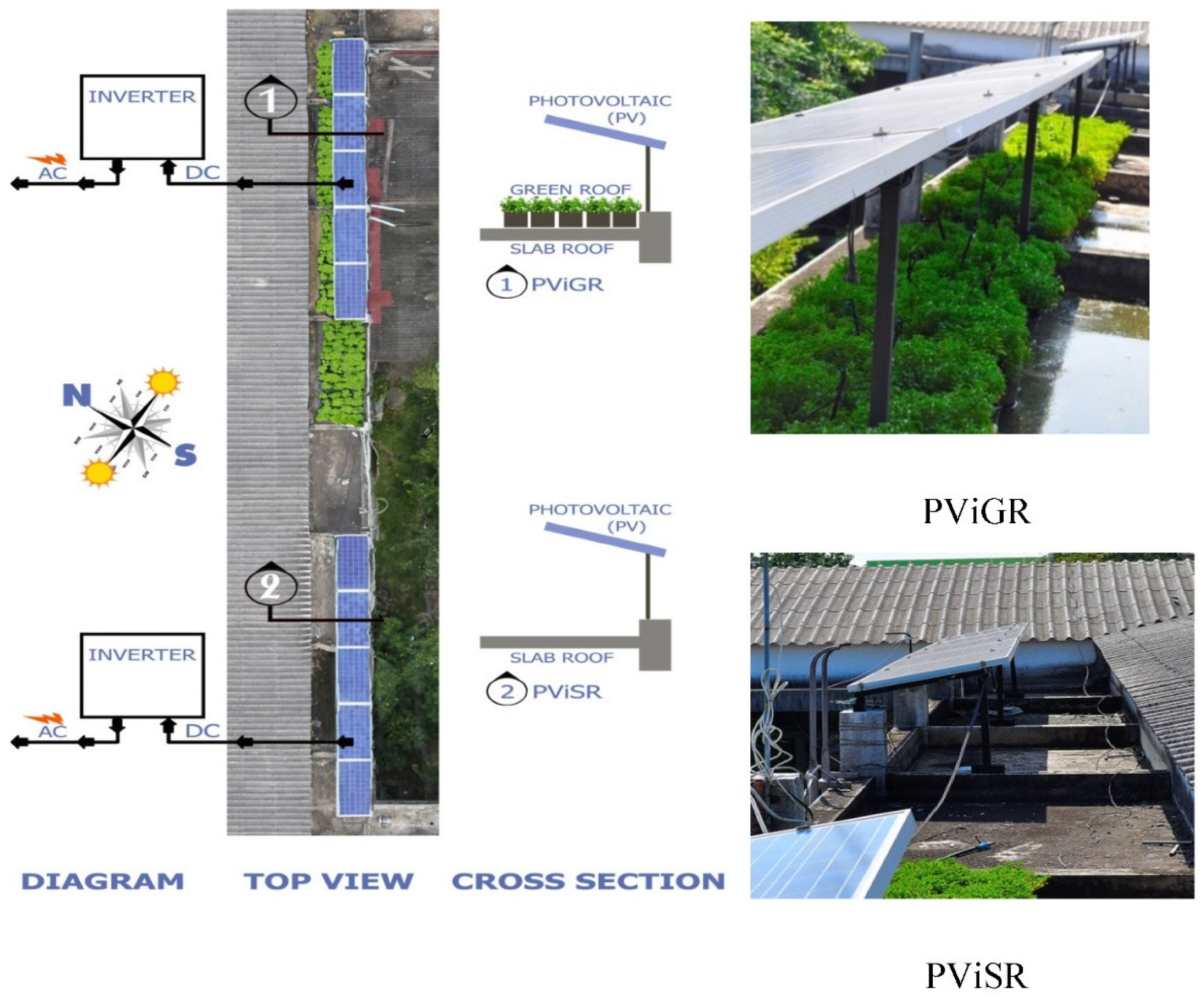
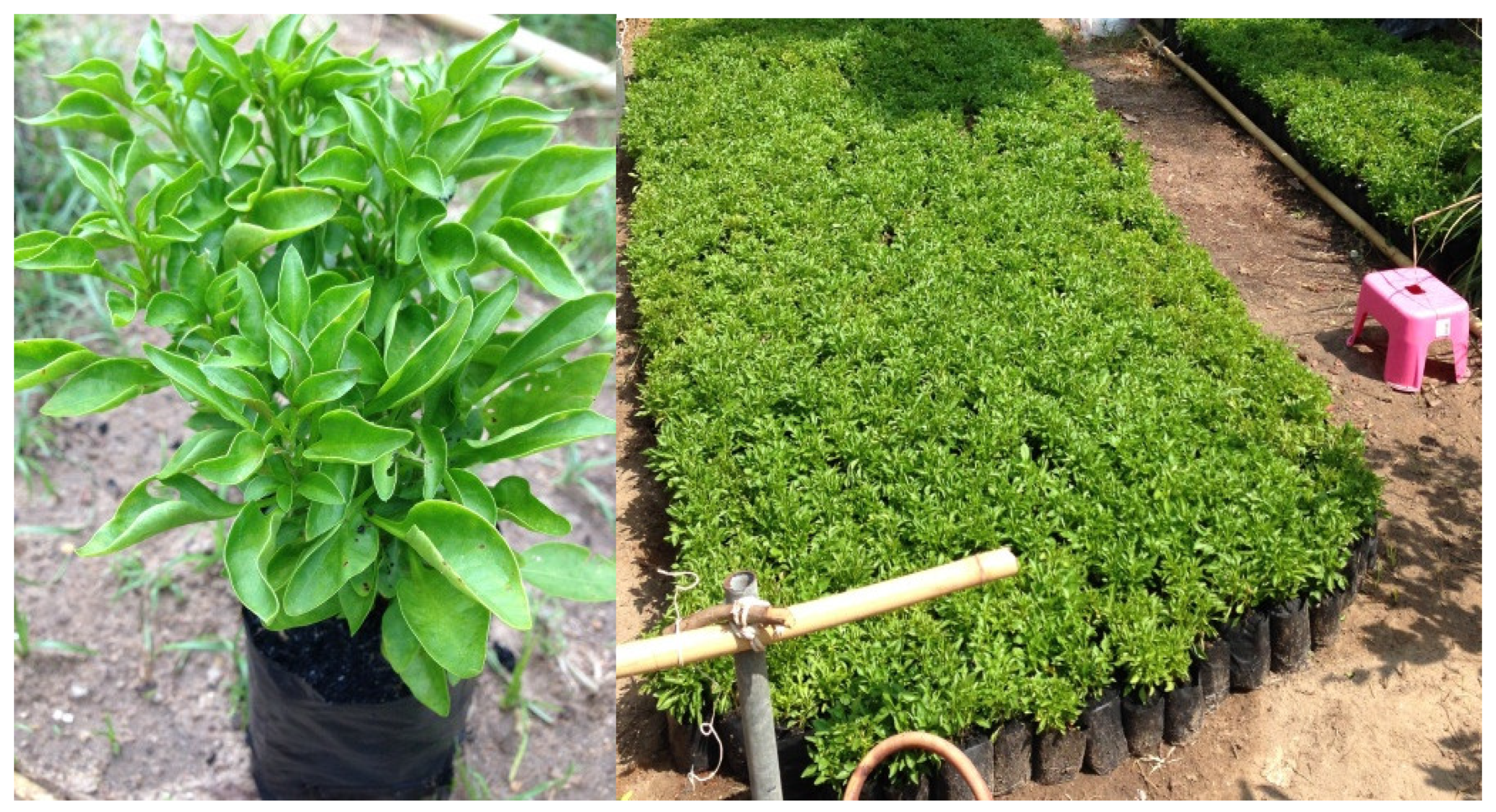
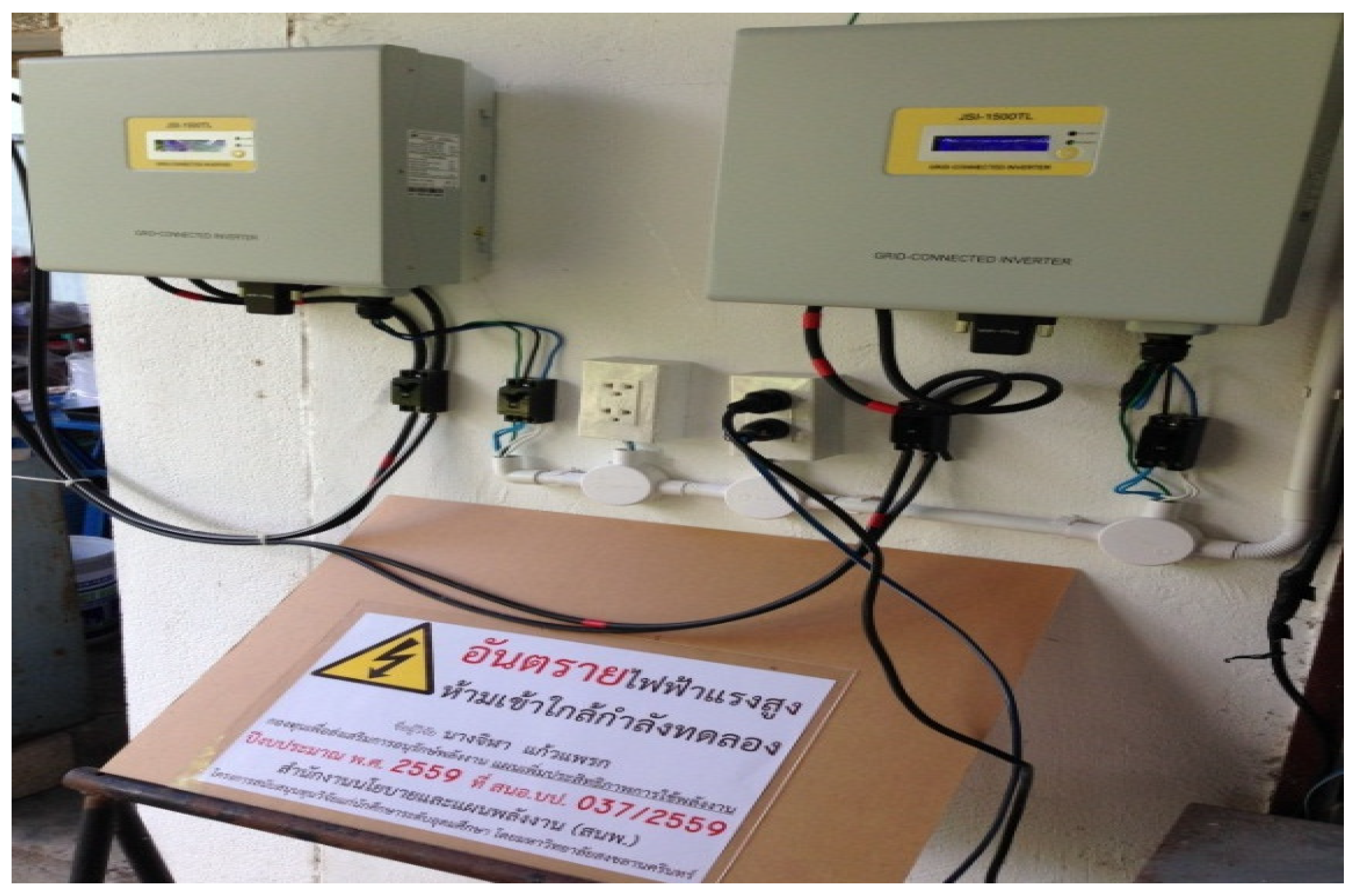
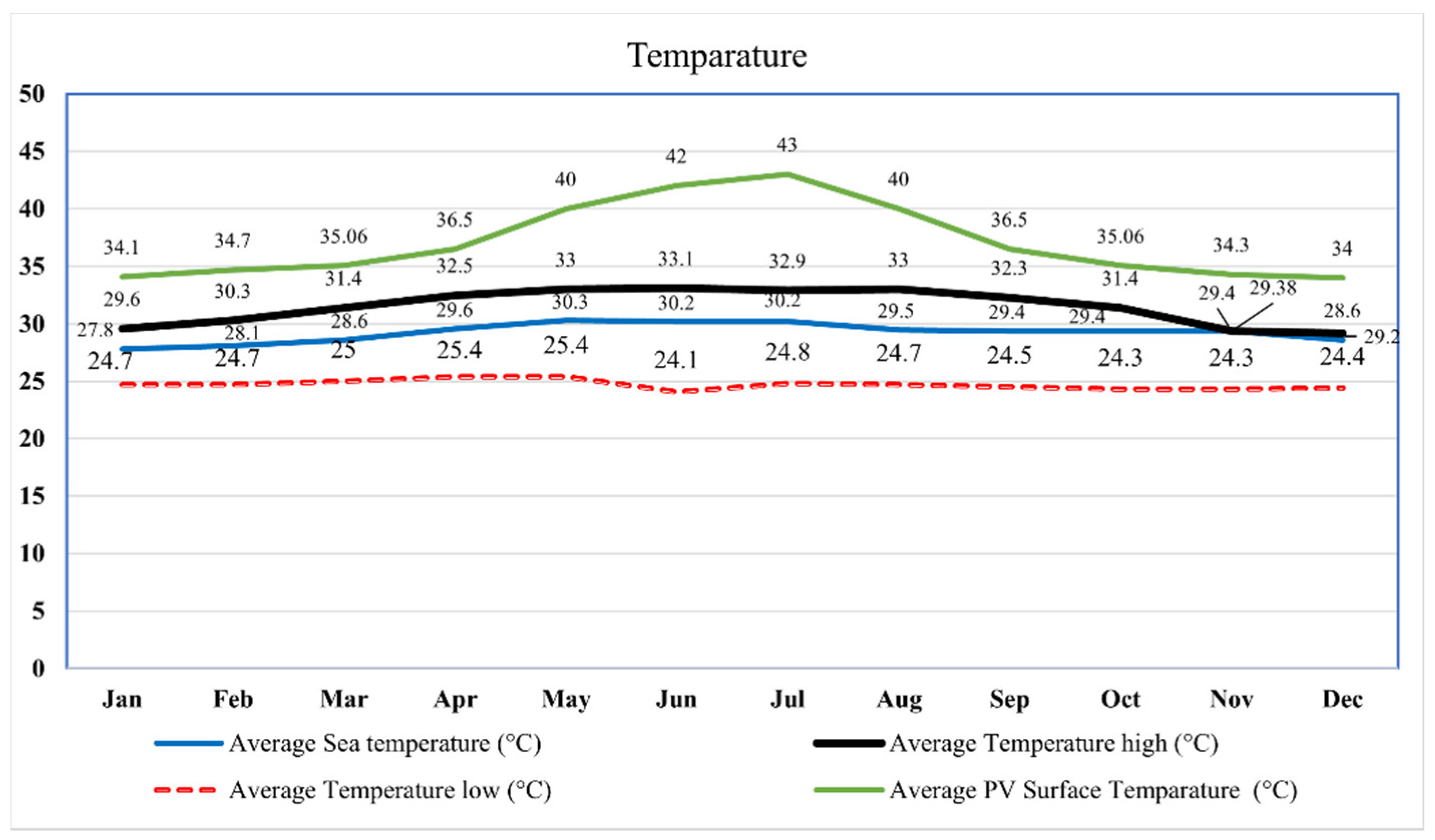
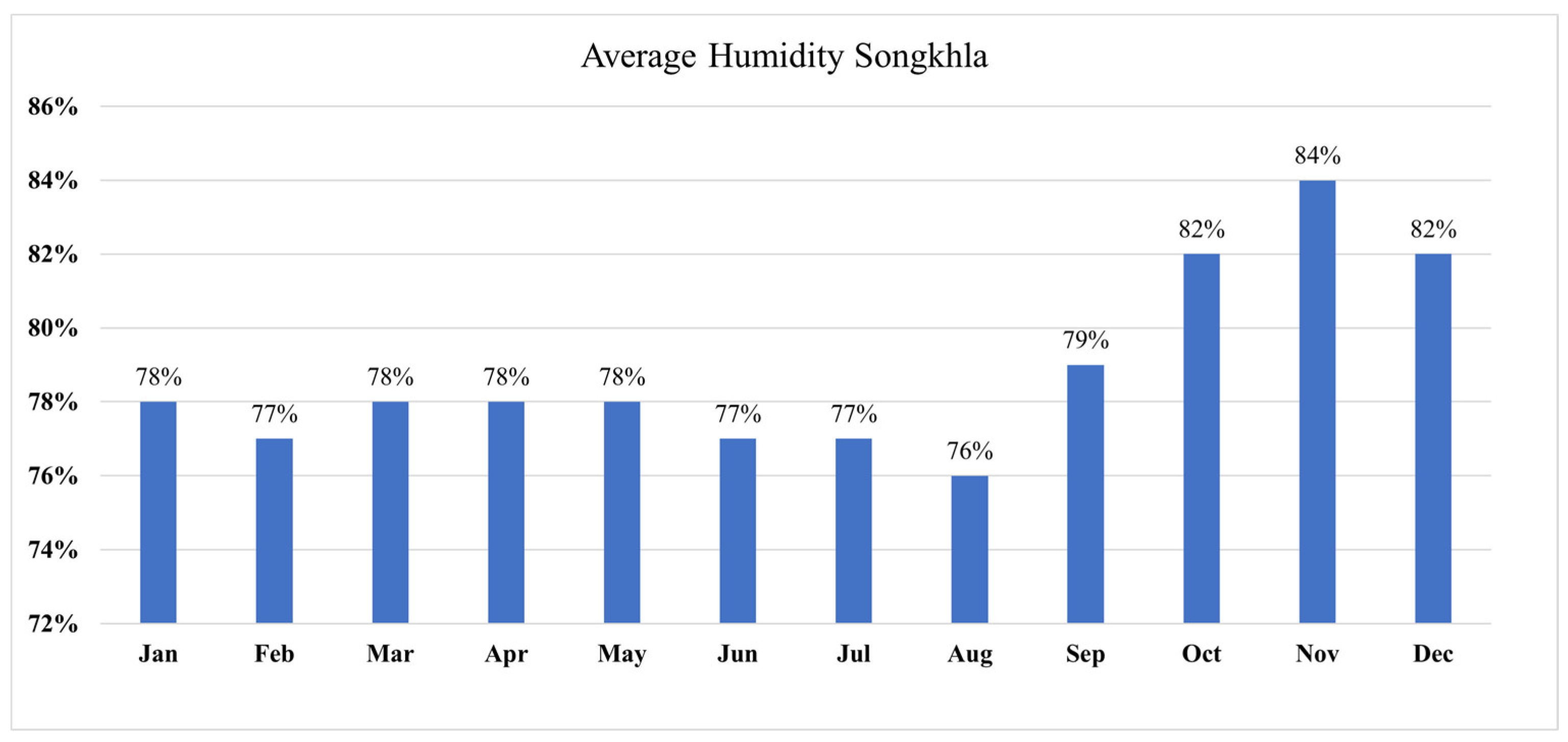
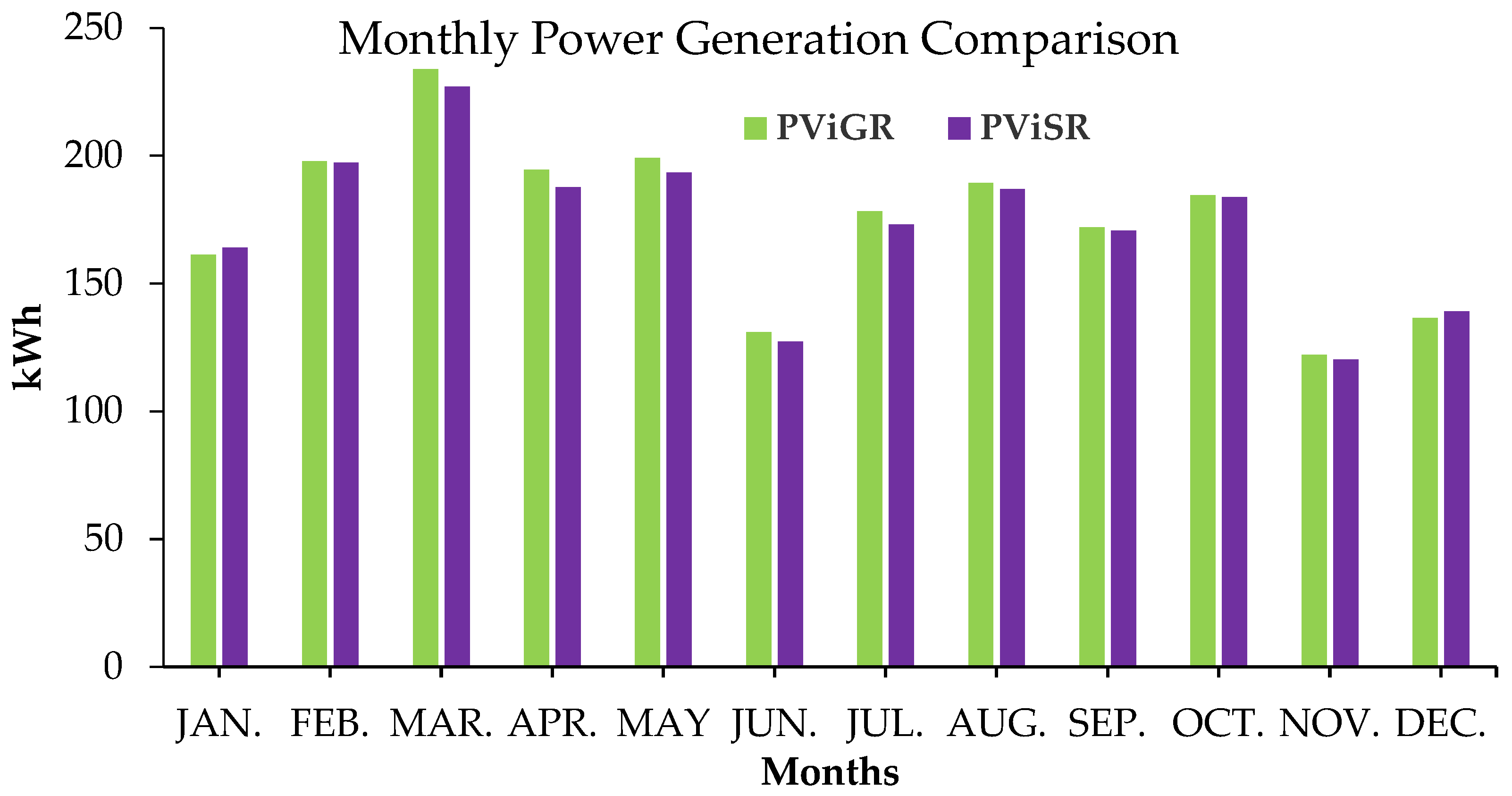

| Site Name | Country/State | City | Address | System Size | Power Now | Today’s Energy | Total Energy |
|---|---|---|---|---|---|---|---|
| PViGR_Chila | Thailand | Songkhla | Rajamangala University of Technology Srivijaya | 1.425 kWp | 0.677 kW | 4.40 kWh | 2.19 MWh |
| PSiSR_Chila | Thailand | Songkhla | Rajamangala University of Technology Srivijaya | 1.425 kWp | 0.745 kW | 4.48 kWh | 2.18 MWh |
| No. | Month | Year | The Power Output of PV Panels (kWh) | Different (kWh) | Percentage of Different | |
|---|---|---|---|---|---|---|
| PViGR | PViSR | |||||
| 1 | January | 2018 | 164.07 | 161.35 | 2.72 | 1.69 |
| 2 | February | 2018 | 197.78 | 197.38 | 0.40 | 0.20 |
| 3 | March | 2018 | 233.88 | 227.07 | 6.81 | 3.00 |
| 4 | April | 2018 | 194.56 | 187.68 | 6.88 | 3.67 |
| 5 | May | 2018 | 199.20 | 193.40 | 5.80 | 3.00 |
| 6 | June | 2017 | 131.08 | 127.26 | 3.82 | 3.00 |
| 7 | July | 2017 | 178.32 | 173.13 | 5.19 | 3.00 |
| 8 | August | 2017 | 189.42 | 186.88 | 2.54 | 1.36 |
| 9 | September | 2017 | 171.96 | 170.76 | 1.20 | 0.70 |
| 10 | October | 2017 | 184.63 | 183.78 | 0.85 | 0.46 |
| 11 | November | 2017 | 122.11 | 120.22 | 1.89 | 1.57 |
| 12 | December | 2017 | 139.14 | 136.47 | 2.67 | 1.96 |
| Total | 2106.15 | 2065.38 | 40.77 | 1.97 | ||
| Periods | Months | Power Output of PVpanels (kWh) | Total (kWh) | Percentage | |
|---|---|---|---|---|---|
| PViGR | PViSR | ||||
| 1 | Dec–Feb | 500.99 | 495.20 | 996.19 | 23.88 |
| 2 | Mar–May | 627.64 | 08.15 | 1235.79 | 29.64 |
| 3 | Jun–Aug | 498.82 | 487.27 | 986.09 | 23.64 |
| 4 | Sep–Nov | 478.70 | 474.76 | 953.46 | 22.86 |
Publisher’s Note: MDPI stays neutral with regard to jurisdictional claims in published maps and institutional affiliations. |
© 2021 by the authors. Licensee MDPI, Basel, Switzerland. This article is an open access article distributed under the terms and conditions of the Creative Commons Attribution (CC BY) license (https://creativecommons.org/licenses/by/4.0/).
Share and Cite
Kaewpraek, C.; Ali, L.; Rahman, M.A.; Shakeri, M.; Chowdhury, M.S.; Jamal, M.S.; Mia, M.S.; Pasupuleti, J.; Dong, L.K.; Techato, K. The Effect of Plants on the Energy Output of Green Roof Photovoltaic Systems in Tropical Climates. Sustainability 2021, 13, 4505. https://doi.org/10.3390/su13084505
Kaewpraek C, Ali L, Rahman MA, Shakeri M, Chowdhury MS, Jamal MS, Mia MS, Pasupuleti J, Dong LK, Techato K. The Effect of Plants on the Energy Output of Green Roof Photovoltaic Systems in Tropical Climates. Sustainability. 2021; 13(8):4505. https://doi.org/10.3390/su13084505
Chicago/Turabian StyleKaewpraek, Chila, Liaqat Ali, Md. Arefin Rahman, Mohammad Shakeri, M. S. Chowdhury, M. S. Jamal, Md. Shahin Mia, Jagadeesh Pasupuleti, Le Khac Dong, and Kuaanan Techato. 2021. "The Effect of Plants on the Energy Output of Green Roof Photovoltaic Systems in Tropical Climates" Sustainability 13, no. 8: 4505. https://doi.org/10.3390/su13084505
APA StyleKaewpraek, C., Ali, L., Rahman, M. A., Shakeri, M., Chowdhury, M. S., Jamal, M. S., Mia, M. S., Pasupuleti, J., Dong, L. K., & Techato, K. (2021). The Effect of Plants on the Energy Output of Green Roof Photovoltaic Systems in Tropical Climates. Sustainability, 13(8), 4505. https://doi.org/10.3390/su13084505











